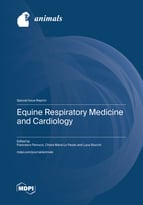Equine Respiratory Medicine and Cardiology
A special issue of Animals (ISSN 2076-2615). This special issue belongs to the section "Equids".
Deadline for manuscript submissions: closed (20 January 2023) | Viewed by 26535
Special Issue Editors
Interests: equine internal medicine; equine sports medicine; respiratory diseases; cardiac disorders
Interests: equine; internal medicine; sports medicine; respiratory medicine; equine asthma
Special Issue Information
Dear Colleagues,
Diseases involving the respiratory system of the horse are a major concern in equine internal medicine. In fact, up to 15% of horses living in the Northern Hemisphere suffer from equine asthma. In foals, respiratory infections represent one of the most relevant issues in stud management; in racehorses, respiratory disorders are the second most common cause of reduced performance after orthopaedic diseases.
Moreover, respiratory affections are often associated with cardiovascular dysfunction. Racehorses with atrial fibrillation, for example, can suffer from exercise-induced pulmonary haemorrhage. Severe respiratory infections can be related to endocarditis; in severely asthmatic horses, the remodelling of the airways also involves the pulmonary arteries, leading to pulmonary hypertension and cor pulmonale.
Therefore, the study of respiratory and cardiovascular diseases is currently a hot topic in equine medicine. For this reason, we are proposing a Special Issue titled “Equine Respiratory Medicine and Cardiology”, and we invite you to submit your research papers reporting the latest results of your work or interesting clinical cases on this topic.
Prof. Dr. Francesco Ferrucci, DVM
Dr. Chiara Maria Lo Feudo
Dr. Luca Stucchi
Guest Editors
Manuscript Submission Information
Manuscripts should be submitted online at www.mdpi.com by registering and logging in to this website. Once you are registered, click here to go to the submission form. Manuscripts can be submitted until the deadline. All submissions that pass pre-check are peer-reviewed. Accepted papers will be published continuously in the journal (as soon as accepted) and will be listed together on the special issue website. Research articles, review articles as well as short communications are invited. For planned papers, a title and short abstract (about 100 words) can be sent to the Editorial Office for announcement on this website.
Submitted manuscripts should not have been published previously, nor be under consideration for publication elsewhere (except conference proceedings papers). All manuscripts are thoroughly refereed through a single-blind peer-review process. A guide for authors and other relevant information for submission of manuscripts is available on the Instructions for Authors page. Animals is an international peer-reviewed open access semimonthly journal published by MDPI.
Please visit the Instructions for Authors page before submitting a manuscript. The Article Processing Charge (APC) for publication in this open access journal is 2400 CHF (Swiss Francs). Submitted papers should be well formatted and use good English. Authors may use MDPI's English editing service prior to publication or during author revisions.
Keywords
- horse
- equine asthma
- pneumonia
- exercise-induced pulmonary hemorrhage
- endoscopy
- bronchoalveolar lavage fluid
- poor performance
- heart disease
- echocardiography
- cardiac arrhythmia







